The Intel Ivy Bridge (Core i7 3770K) Review
by Anand Lal Shimpi & Ryan Smith on April 23, 2012 12:03 PM EST- Posted in
- CPUs
- Intel
- Ivy Bridge
The Lineup: Quad-Core Only for Now
Very telling of how times have changed is that today's Ivy Bridge launch only comes with a single Extreme Edition processor—the Core i7-3920XM, a mobile part. There are some great enthusiast desktop parts of course, but as with Sandy Bridge the desktop Extreme Edition is reserved for another platform. In this case, we're talking about LGA-2011 which won't launch in an Ivy flavor until the end of this year/early next year at this point.
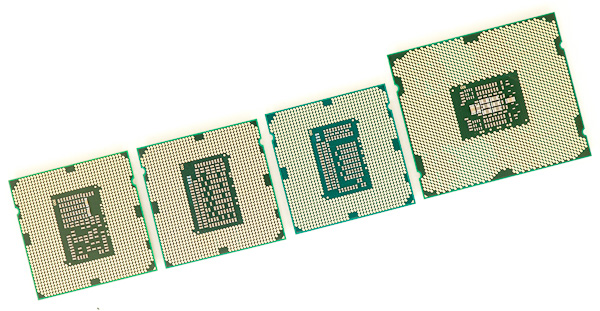
From left to right: Clarkdale, Sandy Bridge, Ivy Bridge, Sandy Bridge E
Contrary to everything I've been saying thus far however is the nature of the launch: only quad-core parts will be available first. The dual-core, and more importantly for Ivy Bridge, the ultra low voltage parts won't come until May/June. That means the bigger notebooks and naturally the performance desktops will arrive first, followed by the ultraportables, Ultrabooks and more affordable desktops. This strategy makes sense as the volumes for expensive quad-core notebooks and performance desktops in general are lower than cheaper dual-core notebooks/desktops. From what I've heard, the move to 22nm has been the most challenging transition Intel's fab teams have ever faced, which obviously constrains initial supplies.
| Intel 2012 CPU Lineup (Standard Power) | |||||||||
| Processor | Core Clock | Cores / Threads | L3 Cache | Max Turbo | Intel HD Graphics | TDP | Price | ||
| Intel Core i7 3960X | 3.3GHz | 6 / 12 | 15MB | 3.9GHz | N/A | 130W | $999 | ||
| Intel Core i7 3930K | 3.2GHz | 6 / 12 | 12MB | 3.8GHz | N/A | 130W | $583 | ||
| Intel Core i7 3820 | 3.6GHz | 4 / 8 | 10MB | 3.9GHz | N/A | 130W | $294 | ||
| Intel Core i7 3770K | 3.5GHz | 4 / 8 | 8MB | 3.9GHz | 4000 | 77W | $313 | ||
| Intel Core i7 3770 | 3.4GHz | 4 / 8 | 8MB | 3.9GHz | 4000 | 77W | $278 | ||
| Intel Core i5 3570K | 3.4GHz | 4 / 4 | 6MB | 3.8GHz | 4000 | 77W | $212 | ||
| Intel Core i5 3550 | 3.3GHz | 4 / 4 | 6MB | 3.7GHz | 2500 | 77W | $194 | ||
| Intel Core i5 3450 | 3.1GHz | 4 / 4 | 6MB | 3.5GHz | 2500 | 77W | $174 | ||
| Intel Core i7 2700K | 3.5GHz | 4 / 8 | 8MB | 3.9GHz | 3000 | 95W | $332 | ||
| Intel Core i5 2550K | 3.4GHz | 4 / 4 | 6MB | 3.8GHz | N/A | 95W | $225 | ||
| Intel Core i5 2500 | 3.3GHz | 4 / 4 | 6MB | 3.7GHz | 2000 | 95W | $205 | ||
| Intel Core i5 2400 | 3.1GHz | 4 / 4 | 6MB | 3.4GHz | 2000 | 95W | $195 | ||
| Intel Core i5 2320 | 3.0GHz | 4 / 4 | 6MB | 3.3GHz | 2000 | 95W | $177 | ||
There are five 77W desktop parts launching today, three 65W parts and one 45W part. The latter four are either T or S SKUs (lower leakage, lower TDP and lower clocked parts), while the first five are traditional, standard power parts. Note that max TDP for Ivy Bridge on the desktop has been reduced from 95W down to 77W thanks to Intel's 22nm process. The power savings do roughly follow that 18W decrease in TDP. Despite the power reduction, you may see 95W labels on boxes and OEMs are still asked to design for 95W as Ivy Bridge platforms can accept both 77W IVB and 95W Sandy Bridge parts.
We've already gone through Ivy's architecture in detail so check out our feature here for more details if you haven't already.
| Intel 2012 Additional CPU Features (Standard Power) | |||||||||
| Processor | GPU Clock (base) | GPU Clock (max) | PCIe 3.0 | Intel SIPP | Intel vPro | Intel VT-d | Intel TXT | ||
| Intel Core i7 3770K | 650MHz | 1150MHz | Yes | No | No | No | No | ||
| Intel Core i7 3770 | 650MHz | 1150MHz | Yes | Yes | Yes | Yes | Yes | ||
| Intel Core i5 3570K | 650MHz | 1150MHz | Yes | No | No | No | No | ||
| Intel Core i5 3550 | 650MHz | 1150MHz | Yes | Yes | Yes | Yes | Yes | ||
| Intel Core i5 3450 | 650MHz | 1100MHz | Yes | Yes | Yes | Yes | Yes | ||
The successful K-series SKUs are front and center in the Ivy lineup. As you'll remember from Sandy Bridge, anything with a K suffix ships fully unlocked. Ivy Bridge K-series SKUs support multipliers of up to 63x, an increase from the 57x maximum on Sandy Bridge. This won't impact most users unless you're doing any exotic cooling however.
If you don't have a K in your product name then your part is either partially or fully locked. Although this doesn't apply to any of the CPUs launching today, Ivy Bridge chips without support for turbo are fully locked and cannot be overclocked.
If your chip does support turbo boost, then you can overclock via increasing turbo ratios by as much as 4 bins above their standard setting. For example, the Core i7 3550 has a max turbo frequency of 3.7GHz with a single core active. Add another four bins (4 x 100MHz) and you get a maximum overclock of 4.1GHz, with one core active. The other turbo ratios can also be increased by up to four bins.
| Sandy Bridge vs. Ivy Bridge Pricing | |||||
| Sandy Bridge | Price | Price | Ivy Bridge | ||
| Core i7 2700K | $332 | $313 | Core i7 3770K | ||
| Core i7 2600 | $294 | $278 | Core i7 3770 | ||
| Core i5 2550K | $225 | $212 | Core i5 3750K | ||
| Core i5 2500 | $205 | $194 | Core i5 3550 | ||
| Core i5 2400 | $184 | $174 | Core i5 3450 | ||
The 3770K is the new king of the hill and it comes in $19 cheaper than the hill's previous resident: the Core i7 2700K. The non-K version saves you $16 compared to Sandy Bridge. The deltas continue down the line ranging ranging from $10—$19.
Unlike the Sandy Bridge launch, Intel is offering its high-end GPU on more than just K-series desktop parts right away. It is also differentiating K from non-K by adding another 100MHz to the base clock for K series parts. While the Core i7 2600K and Core i7 2600 both ran at 3.3GHz, the 3770 runs at 3.4GHz compared to the 3770K's 3.5GHz. It's a small difference but one that Intel hopes will help justify the added cost of the K.
Classic feature segmentation is alive and well with Ivy Bridge. In the quad-core lineup, only Core i7s get Hyper Threading—Core i5s do not. When the dual-core Core i3s show up in the coming months they will once again do so without support for turbo boost. Features like VT-d and Intel TXT are once again reserved for regular, non-K-series parts alone.


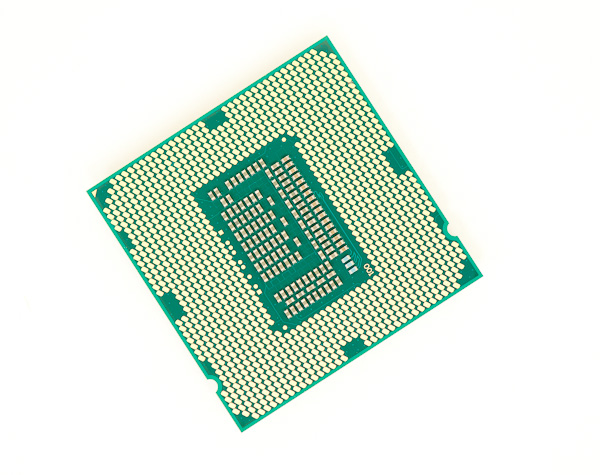
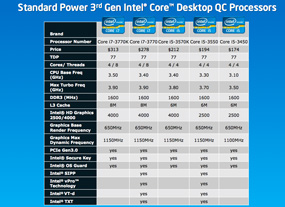
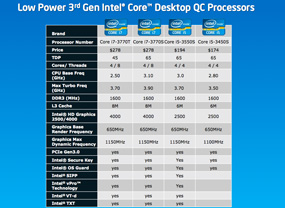
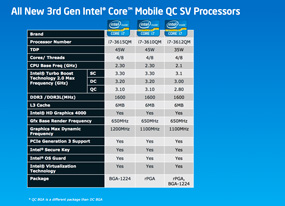
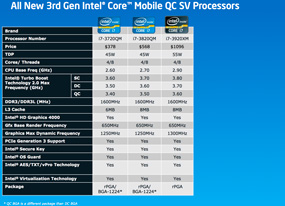








173 Comments
View All Comments
aegisofrime - Monday, April 23, 2012 - link
It's interesting to me that this article doesn't include any temperature measurements. I have been hearing that Ivy Bridge has got temperature issues. Could you update the article with those numbers? I'm aware that the article on undervolting and overclocking has some numbers, but none at stock voltage and clocks as far as I know.Stuka87 - Monday, April 23, 2012 - link
I was just going to post the same thing. Where on earth are the temp measurements?Anand Lal Shimpi - Monday, April 23, 2012 - link
Ian's article thoroughly covers the thermal issues, and did include a stock clock graph with voltage scaling:http://images.anandtech.com/doci/5763/Stock%20Spee...
Take care,
Anand
Stuka87 - Tuesday, April 24, 2012 - link
Thanks for responding Anand.The issue I see is in the future, people will look for this review, and not know to look in another article for temp readings.
And I know the other article did have a temp graph, but it did not have the bar graph comparing it to other CPU's like we are used to. I actually have no clue how it compares to a SNB chip after reading this article in terms of temperatures. It would be great to have that information as it aids in building a new system.
Thanks!
samal90 - Monday, April 23, 2012 - link
Okk...so the A8-3870K beats it in almost every gaming benchmark and they are marketing the HD4000....pretty bad for intel. Trinity will completely destroy Ivy bridge then it seems. Every generation, one company is slacking off behind the other...it's always like that. Next year, intel will take the crown..then the year after it will be AMD...and so on.N4g4rok - Monday, April 23, 2012 - link
Not so sure about that actually. I think they're going to fork in two different directions, with Intel being your high compute power desktop friendly option, and AMD being the go to for laptop, notebook, and ultrabook-esque form factors. Unless trinity mucks up big time, AMD will have the IGP thing down. for a while.JarredWalton - Monday, April 23, 2012 - link
I think you're wrong on the "AMD being the go to for laptop..." part. AMD will be the go-to option for people that want an inexpensive laptop with better IGP performance. As I note in the mobile IVB article, mobile Llano GPU performance isn't nearly as impressive relative to IVB as on the desktop. Anyway, AMD will continue to lead on IGP performance with Trinity I'm sure, but there are very large numbers of laptop users that don't even play games. Of course, the highest selling laptops are still going to be the least expensive laptops.DanNeely - Monday, April 23, 2012 - link
For mainstream laptops the real factor is probably going to be battery life. AMD needs to catch up to Intel with power management to get beyond niche products.seasalt - Monday, April 23, 2012 - link
Why is it listed as 77W when the ones already being sold are clearly marked 95W on the boxes?http://www.nordichardware.com/news/69-cpu-chipset/...
mechwarrior1989 - Monday, April 23, 2012 - link
It's in the article..."Note that max TDP for Ivy Bridge on the desktop has been reduced from 95W down to 77W thanks to Intel's 22nm process. The power savings do roughly follow that 18W decrease in TDP. Despite the power reduction, you may see 95W labels on boxes and OEMs are still asked to design for 95W as Ivy Bridge platforms can accept both 77W IVB and 95W Sandy Bridge parts."